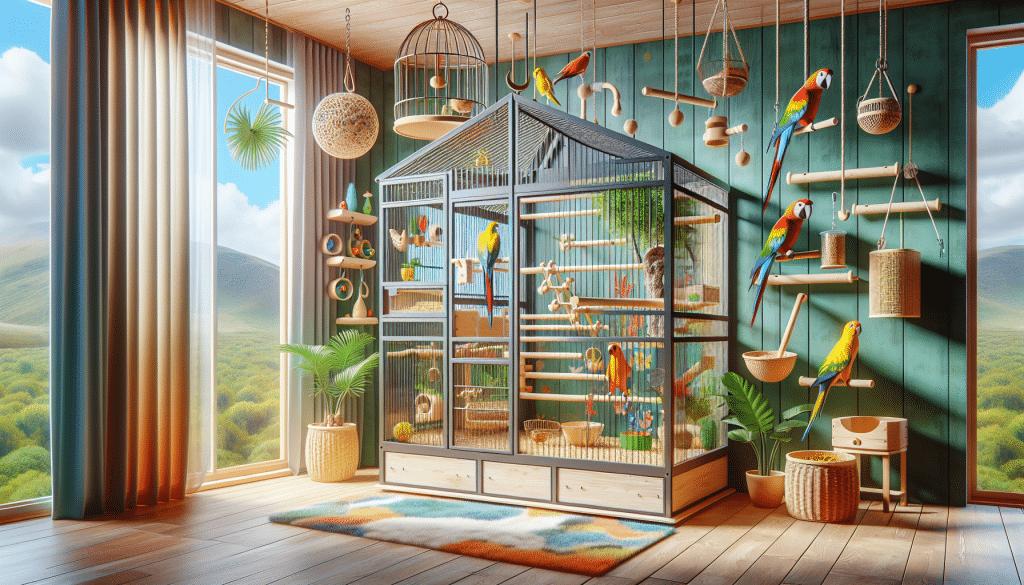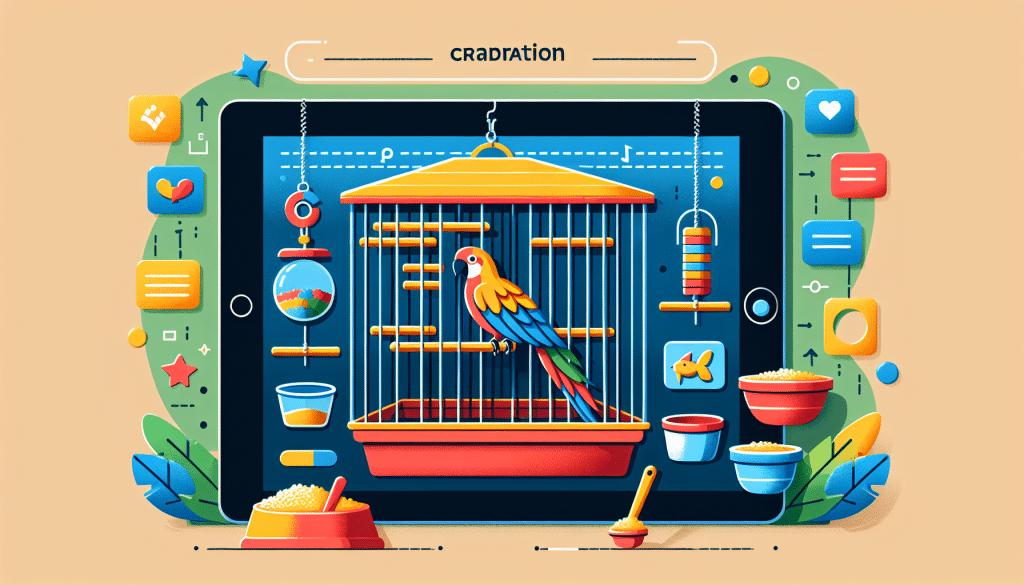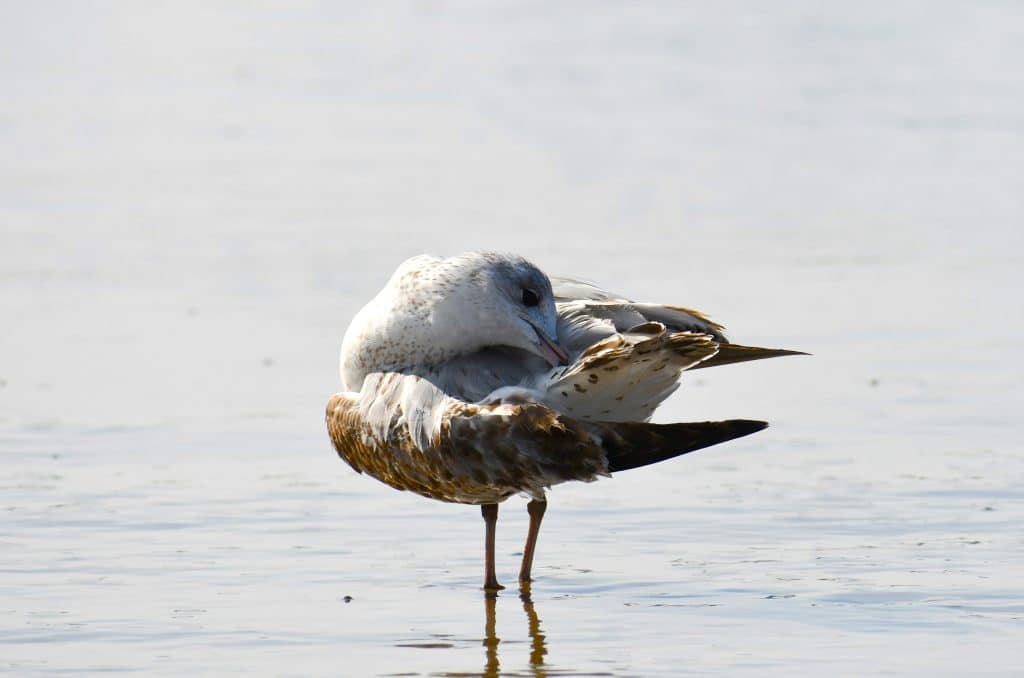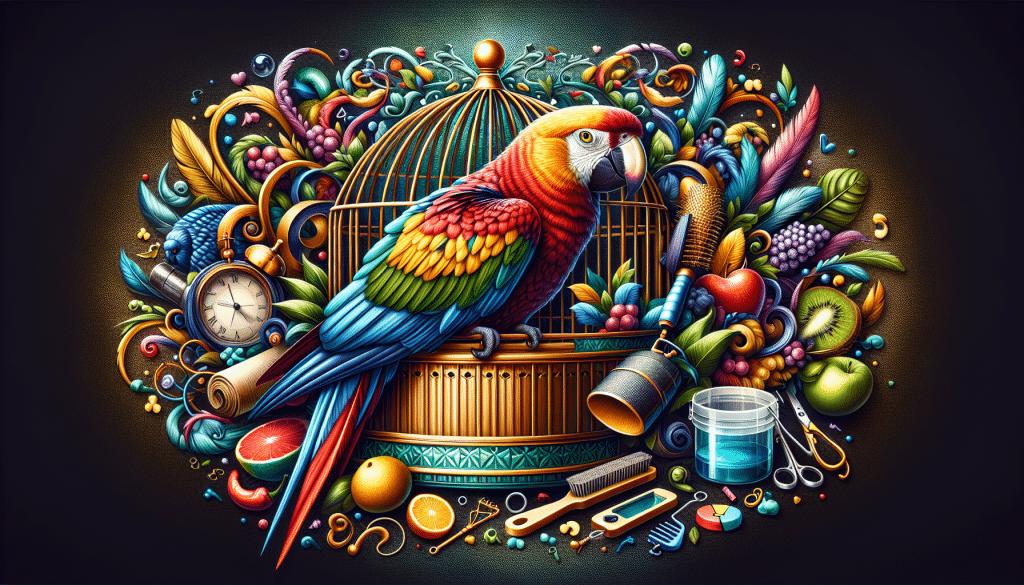Ensuring your parrot has a suitable housing and environment is crucial for its overall well-being and happiness. Just as humans thrive in a comfortable and nurturing environment, so do these intelligent and social birds. From the size and design of the cage to the location and furnishings within it, every element plays a significant role in providing a safe and stimulating space for your feathered friend. In this article, we explore essential factors to consider when creating a suitable housing and environment for your parrot, enabling you to enhance its quality of life and foster a stronger bond between you and your beloved companion.

Understanding Parrot Needs
The Importance of Space
As a responsible parrot owner, understanding the needs of your feathered friend is essential. One of the crucial aspects of providing a suitable housing and environment for your parrot is the availability of ample space. Parrots are intelligent and active creatures that require sufficient room to stretch their wings, exercise, and explore their surroundings. A spacious environment allows them to fly, climb, and engage in natural behaviors, which is vital for their overall physical and mental well-being.
Temperature and Humidity Requirements
In addition to providing adequate space, maintaining the right temperature and humidity levels is crucial for your parrot’s health. Different species have varying temperature preferences, so it is essential to research the specific requirements of your parrot. Generally, temperatures between 65 to 80°F (18 to 27°C) are suitable for most parrots. It’s important to keep the environment free from drafts and avoid placing the cage in direct sunlight or near air conditioning units.
Humidity is also an essential factor to consider. Parrots originate from tropical regions, where humidity levels are relatively high. Mimicking this natural environment by maintaining a humidity level of around 50-60% is beneficial for your parrot’s respiratory health. Use a hygrometer to monitor humidity levels and consider using a humidifier or misting the cage with clean water to achieve the required level.
The Need for Natural Light
Just like humans, parrots need exposure to natural light to maintain their overall health. Sunlight provides important vitamin D3, which is necessary for proper calcium absorption in their bodies. Whenever possible, provide access to natural sunlight by placing the cage near a window. However, it’s crucial to ensure that the cage is not exposed to direct sunlight for extended periods, as this can lead to overheating or discomfort for your parrot.
If natural sunlight is not readily available, artificial full-spectrum lighting can serve as an alternative. These lights mimic the sun’s spectrum and help fulfill your parrot’s light requirements. Ensure the lighting is situated at a suitable distance from the cage and follow recommendations for the duration of exposure.
Social Interaction and Mental Stimulation
Parrots are highly social creatures and require regular interaction with their human caregivers and other parrot companions. Lack of socialization can lead to behavioral issues and emotional distress. Make sure to spend quality time with your parrot daily, engaging in activities such as talking, singing, playing, and training.
Alongside social interaction, providing mental stimulation is equally crucial. Parrots are intelligent animals that thrive on mental challenges. Offering a variety of toys, puzzles, and games can keep your parrot entertained and mentally engaged. Enrichment activities such as foraging games, puzzle toys, and rotating toys can keep your parrot’s mind active and prevent boredom.
Choosing the Right Cage
Size and Shape Considerations
When it comes to choosing a cage for your parrot, size matters. A spacious cage provides your parrot with the freedom to move around, stretch its wings, and engage in natural behaviors. Select a cage that offers sufficient horizontal and vertical room for your specific parrot species. Your parrot should be able to fully extend its wings without touching the cage walls or accessories.
Consider the shape of the cage as well. A rectangular or square-shaped cage is generally preferred over round or curved cages, as they allow for better utilization of space and provide more climbing opportunities.
Bar Spacing and Security
Ensure that the bar spacing of the cage is appropriate for your parrot. The gaps between the bars should be narrow enough to prevent your parrot from getting its head or body stuck, while also allowing for good visibility. For smaller parrots, a bar spacing of ½ to ? inches is suitable, while for larger parrots, ¾ to 1 inch spacing is preferable.
Furthermore, the cage should have secure locks or latches to prevent accidental escapes. It’s important to regularly inspect the cage for any signs of wear and tear to ensure the security of your parrot.
Types of Materials for Durability
Choosing the right materials for the cage is important for its durability and your parrot’s safety. Opt for cages made from non-toxic materials such as stainless steel, powder-coated steel, or wrought iron. These materials are sturdy, easy to clean, and resistant to corrosion.
Avoid cages made of materials like galvanized steel, as they can be harmful if ingested. Additionally, be cautious with cages made of materials that are prone to chipping or peeling, as the coating can be toxic when chewed on by your parrot.
Ease of Cleaning and Maintenance
Proper cage hygiene is vital for your parrot’s health. Choose a cage that is easy to clean and maintain. Look for features such as removable trays, grate bottoms, and easy access to all parts of the cage. This will enable you to clean droppings, food debris, and other waste regularly. Regular cleaning prevents the build-up of harmful bacteria, ensuring a safe and healthy environment for your parrot.

Cage Placement
Safe Locations within the Home
Selecting an appropriate location for your parrot’s cage is crucial for its well-being. Choose a place that is free from drafts, excessive noise, and sudden temperature changes. Avoid positioning the cage in areas where it will be exposed to direct sunlight or near air vents or open windows.
Ensure that the cage is placed at a comfortable height, allowing your parrot to interact with family members at eye level. This promotes socialization and helps your parrot feel like a valued member of the family.
Avoiding Hazards and Noxious Fumes
Parrots are sensitive to certain substances and fumes, many of which are commonly found in households. Keep your parrot’s cage away from areas where cleaning products, aerosol sprays, and strong-smelling chemicals are used. These can be toxic and harmful to your parrot’s respiratory system.
Additionally, be cautious with non-stick cookware and appliances, as the fumes emitted when overheated can be lethal to parrots. Provide proper ventilation in the room where the cage is located to ensure a fresh and clean environment.
Considering Human Interaction
While parrots thrive on social interaction, it’s essential to strike a balance between providing companionship and respecting their need for downtime. Position the cage in an area where your parrot can observe and interact with family members without feeling overwhelmed or constantly disturbed. Having a quiet space nearby where your parrot can retreat to when needed is also beneficial.
Access to Windows and Views
Parrots enjoy observing their surroundings and engaging with the outside world. Placing the cage near a window can provide visual stimulation for your parrot. However, be mindful of exposing your parrot to excessive heat, direct sunlight, or cold drafts that may occur near windows. Ensure the cage is positioned to provide a safe and comfortable viewing experience for your parrot.
Creating a Stimulating Interior
Types of Perches and Placement
Parrots spend a significant amount of time on perches, so choosing the right types and placement is essential. Provide a variety of perches with different textures and diameters to promote foot health and prevent pressure sores. Natural wooden perches, rope perches, and branches of varying thicknesses are excellent options.
Place perches strategically throughout the cage to offer different levels and create a stimulating environment for your parrot. Consider placing perches near food and water dishes, cuddle spots, and favorite toys to encourage natural behaviors and a sense of security.
Selection of Toys for Mental Engagement
Toys play a crucial role in keeping your parrot mentally stimulated and preventing boredom. Choose a variety of toys that offer different textures, colors, and shapes to cater to your parrot’s preferences. Toys that encourage foraging, problem-solving, shredding, and chewing are particularly beneficial.
Rotate and introduce new toys regularly to maintain your parrot’s interest. This helps prevent them from becoming bored with their surroundings and promotes mental engagement and overall happiness.
Feeding Dishes and Foraging Areas
Eating is an essential activity for parrots, and providing suitable feeding dishes and foraging opportunities is crucial. Whether using dishes or foraging toys, ensure they are made from safe and non-toxic materials. Stainless steel or ceramic dishes are easy to clean and prevent the transfer of harmful chemicals.
Consider adding foraging toys or incorporating natural materials, such as untreated wood, to create interactive feeding experiences for your parrot. Foraging stimulates their natural instincts and encourages mental and physical activity.
Rotating Accessories to Avoid Boredom
Parrots are intelligent creatures that thrive on change and variety. By rotating their accessories, such as perches, toys, and feeding arrangements, you can keep your parrot’s environment fresh and exciting. This prevents boredom and stimulates their curiosity. Introduce new items gradually and observe your parrot’s response to ensure their safety and comfort.

Incorporating Natural Elements
Adding Plants Safe for Parrots
Bringing a touch of nature into your parrot’s environment can have numerous benefits. Adding safe and non-toxic plants to their surroundings can enhance their well-being. Research which plants are safe for parrots, as some common household plants can be toxic if ingested.
Plants provide visual stimulation, improve air quality, and create a more natural and calming habitat for your parrot. Ensure that the plants are placed in areas where your parrot cannot access or chew on them, as some leaves and flowers may still be toxic.
Using Branches and Natural Perches
In addition to artificial perches, incorporating branches and natural perches into your parrot’s cage can provide an enriching and more natural environment. Ensure the branches are safe for your parrot, free from toxic substances, and properly cleaned and disinfected before use.
Natural perches offer varying textures, which promote foot health and exercise. They also provide opportunities for climbing, gripping, and exploring, fulfilling your parrot’s desire for a diverse and stimulating environment.
The Benefits of Exposure to Nature
Exposing your parrot to natural elements and outdoor experiences can greatly contribute to their overall well-being. Consider setting up a secure outdoor aviary or providing supervised outdoor time for your parrot to enjoy fresh air, sunlight, and the sounds and sights of nature.
Outdoor exposure stimulates natural behaviors, encourages exercise, and provides mental enrichment. However, always ensure that your parrot’s outdoor environment is safe, protected from predators, and free from toxic plants or other hazards.
Simulating a Natural Habitat
While it may not be possible to replicate a parrot’s natural habitat entirely, incorporating elements that mimic their natural environment can greatly benefit their overall happiness and health. Consider providing materials such as natural branches, untreated wood, and grassy perches to simulate a more natural habitat.
Additionally, adding soundscapes or recordings of familiar outdoor sounds, such as natural bird calls or gentle rain, can enhance your parrot’s environment and create a sense of calm and security.
Ensuring Proper Nutrition
Balanced Diet for Parrots
Proper nutrition is vital for your parrot’s overall health and longevity. A balanced diet should consist of a variety of fresh fruits, vegetables, high-quality pellets, and small amounts of seeds or nuts. Consult with a avian veterinarian or avian nutritionist to determine the specific dietary requirements for your parrot species.
Offer a diverse range of food items to provide essential vitamins, minerals, and antioxidants. Ensure that fresh food is provided daily and remove any uneaten portions promptly to maintain cleanliness and prevent the growth of harmful bacteria.
Fresh Foods and Dietary Supplements
Parrots benefit greatly from the inclusion of fresh foods in their diet. Offer a selection of washed, chopped, and appropriately sized fruits and vegetables. Aim for a variety that includes greens like kale and spinach, as well as vitamin-rich options like sweet potatoes, bell peppers, and berries.
Dietary supplements, such as calcium and vitamin D3, may be necessary to ensure your parrot receives all the necessary nutrients. Consult with an avian veterinarian to determine if dietary supplementation is required for your specific parrot and to determine the appropriate dosage.
Toxic Foods to Avoid
While offering a diverse range of foods, it’s essential to be aware of toxic foods that can be harmful or even life-threatening to your parrot. Some common foods to avoid include chocolate, caffeine, avocado, alcohol, onions, garlic, mushrooms, and certain fruits with pits, like cherries or peaches. Always research and consult with a avian veterinarian to confirm the safety of any new food items before adding them to your parrot’s diet.
Feeding Schedule and Practices
Establishing a consistent feeding schedule is beneficial for your parrot’s overall well-being. Provide meals at regular intervals throughout the day and monitor your parrot’s appetite and body condition. Avoid overfeeding, as obesity can lead to serious health complications. Fresh water should be available at all times, and the water dish should be cleaned and refilled daily.
In addition to regular meals, offering occasional treats or special foods as rewards during training sessions can help strengthen the bond between you and your parrot.
Aviaries and Outdoor Environments
Designing an Outdoor Aviary
If you have the space and resources, providing an outdoor aviary can greatly enhance your parrot’s quality of life. Aviaries offer more space and natural stimuli, allowing your parrot to engage in flight, exercise, and social interactions. When designing an outdoor aviary, consider the specific needs of your parrot species, including perching options, feeding stations, and sheltered areas.
Ensure that the aviary is secure, predator-proof, and provides protection from the elements. Regularly inspect the structure for any signs of wear and tear, and maintain cleanliness to prevent the spread of disease.
Protection from Predators and Weather
The safety and security of your parrot should be a top priority in any outdoor environment. Ensure that the aviary is constructed with sturdy materials and secure locks to prevent escapes or unauthorized entry by predators.
Consider natural and artificial barriers such as wire mesh, fences, or netting to provide an additional layer of protection. Ensure that the aviary is located away from areas where predators may gather, such as bushes or trees.
Additionally, provide adequate shelter within the aviary to protect your parrot from extreme temperatures, rain, or direct sunlight.
Outdoor Exercise and Sunlight Benefits
Outdoor exposure provides an array of benefits for your parrot’s physical and mental health. Fresh air and natural sunlight offer essential vitamin D3, which promotes calcium absorption and prevents related health issues. Regular exercise in a spacious outdoor area allows your parrot to stretch its wings, engage in natural behaviors, and maintain muscle tone.
Ensure that your parrot has ample opportunities for flight and provide perches, swings, and climbing structures to encourage exercise and physical activity.
Seasonal Considerations for Outdoor Housing
As the seasons change, it’s important to make necessary adjustments to your parrot’s outdoor housing. During colder months, provide adequate insulation, heating, and shelter to protect your parrot from harsh temperatures. Adding blankets or heat lamps can help maintain a comfortable environment.
In hotter months, shade and proper ventilation become essential. Provide sheltered areas within the aviary and ensure that there is adequate airflow to prevent overheating. Offer fresh water frequently to help your parrot stay hydrated.
Safety and Security Measures
Preventing Escapes
Parrots are intelligent and curious creatures, making it essential to take precautions to prevent escapes. Regularly inspect the cage for any signs of damage, loose bars or latches, or areas where your parrot may be able to chew or squeeze through. Reinforce any weak spots or repair any damage promptly.
Ensure that all doors and access points to the room where your parrot is located are securely closed, and be cautious when entering or exiting to prevent your parrot from escaping. Supervision is key in preventing accidental escapes and ensuring your parrot’s safety.
Safety from Other Pets
If you have other pets in your household, it’s essential to create a safe environment for your parrot. Some household pets, such as cats or dogs, may view parrots as prey or engage in predatory behaviors. Keep the parrot’s cage in an area that is inaccessible to other pets when you are not able to supervise their interactions.
Always supervise any interactions between your parrot and other animals, and only allow positive and controlled interactions under close supervision.
Regular Cage Inspections
Regularly inspecting your parrot’s cage is crucial for maintaining a safe and secure environment. Check for any signs of wear and tear, loose or damaged bars, broken perches, or potential hazards within the cage. Ensure that all locks and latches are functioning properly and that the cage is securely positioned.
Inspecting the cage also allows you to monitor for any signs of damage or wear that may pose a risk to your parrot’s safety.
Emergency Preparedness for Parrots
Preparing for emergencies is vital to safeguard your parrot’s well-being. Familiarize yourself with emergency procedures specific to your area, such as evacuation plans and contacts for avian veterinarians. Keep a first aid kit for birds readily available, including supplies for wound care and basic medical emergencies.
Consider having a backup plan in place in case of power outages or other emergencies that may disrupt your parrot’s environment. This may include alternative heating or cooling methods, backup cages, or a temporary relocation plan if necessary.
Hygiene and Health
Regular Cleaning Routines
Maintaining a clean environment is crucial for your parrot’s health and well-being. Establish a regular cleaning routine to ensure that the cage, perches, toys, and surrounding areas are kept clean and free from waste and debris. Remove droppings and wet food promptly to prevent the spread of bacteria.
Regularly clean and disinfect the cage using bird-safe cleaning products. Avoid using harsh chemicals or cleaning agents that may be toxic to your parrot. Consult with an avian veterinarian for recommended cleaning products.
Disinfection and Parasite Control
In addition to regular cleaning, periodic disinfection is essential to prevent the spread of harmful bacteria and parasites. Disinfect the cage, perches, and toys using avian-safe disinfectants according to the manufacturer’s instructions.
Monitor your parrot for any signs of parasites such as mites or fleas. Consult with an avian veterinarian if you suspect a parasitic infestation and follow their recommended treatment plan.
Recognizing Signs of Stress and Illness
Regular observation of your parrot is crucial for early detection of any signs of stress or illness. Be mindful of changes in behavior, appetite, droppings, or physical appearance. Symptoms such as lethargy, loss of appetite, excessive feather plucking, or abnormal breathing should be taken seriously and promptly addressed by a veterinarian specializing in avian medicine.
Knowing and understanding your parrot’s normal behavior patterns enables you to recognize any deviations, seek appropriate veterinary care, and provide necessary support.
Bathing and Grooming Requirements
Bathing is not only important for hygiene but also for the overall well-being of your parrot. Offer your parrot opportunities for bathing, whether it’s through a shallow dish for them to splash in or misting them with clean water. Some parrots enjoy showering with their owners, while others prefer bathing on their own.
Groom your parrot’s feathers regularly, checking for any signs of feather damage or abnormalities. If necessary, consult with an avian veterinarian or bird groomer for professional grooming services.
Continued Education and Resources
Books and Online Resources for Parrot Care
Ongoing education is essential as a parrot owner, and there are many resources available to expand your knowledge. Books dedicated to parrot care, behavior, health, and training can provide valuable insights and guidance. Look for reputable authors and publications that align with the specific needs of your parrot species.
In addition to books, numerous online resources, blogs, forums, and articles are available to enhance your understanding of parrot care. However, ensure that the information obtained is from reputable sources and consult with an avian veterinarian when in doubt.
Local Parrot Clubs and Societies
Connecting with local parrot clubs and societies can offer numerous benefits for both you and your parrot. These groups often organize educational events, workshops, and social gatherings where you can learn from experienced parrot owners and professionals. Networking with fellow parrot enthusiasts provides invaluable support and opportunities to exchange knowledge and experiences.
Veterinary Care and Expert Advice
Establishing a relationship with an avian veterinarian is essential for your parrot’s health. Regular wellness check-ups, preventative care, and prompt veterinary attention when needed are crucial for the overall well-being of your parrot.
Consult with an avian veterinarian for expert advice on any aspect of parrot care, including nutrition, behavior, enrichment, and health concerns. They can provide guidance specific to your individual parrot and help address any questions or concerns you may have.
Attending Workshops and Seminars
Attending workshops and seminars focused on parrot care and behavior can provide valuable insights and practical knowledge. These educational events often feature renowned experts in avian medicine, behavior, and training who can offer guidance based on years of experience. Check local listings, veterinary clinics, or avian organizations for upcoming workshops or conferences in your area.
Continued education ensures that you stay updated on the latest information and advancements in parrot care, enabling you to provide the best possible housing, environment, and overall care for your feathered companion.
In conclusion, understanding and meeting the needs of your parrot when it comes to housing and environment is crucial for their well-being, happiness, and longevity. Providing ample space, appropriate temperature and humidity levels, natural light, social interaction, mental stimulation, and a balanced diet are fundamental aspects. Ensuring a suitable cage, proper placement, stimulating interior, balanced nutrition, outdoor options, safety measures, hygiene, and continued education are essential elements in creating a healthy and enriching environment for your beloved parrot. By following these guidelines and investing time and effort into meeting your parrot’s needs, you can create a suitable and fulfilling home for your feathered friend.



